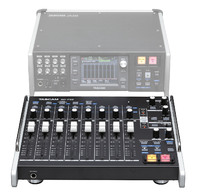 TASCAM recently released (October 2016) new firmware for their HS-P82 multi-track timecode location recorder. Firmware build v2.00 is the first update for the HS-P82 since a couple of years, and marks TASCAM's re-dedication to supporting and improving this product.
TASCAM recently released (October 2016) new firmware for their HS-P82 multi-track timecode location recorder. Firmware build v2.00 is the first update for the HS-P82 since a couple of years, and marks TASCAM's re-dedication to supporting and improving this product.
Over the years, professional users of the recorder have been providing the TASCAM engineers a list of the changes/improvements that we felt would make the recorder even better suited for the role it was intended (film/video production sound).
The rollout of this new firmware represents the first (of hopefully several) wave of new and improved user features.
Build version v. 2.00 covers the following significant changes:
The mirror record functionality has been improved so that changes to one card will carry over to both cards (such as scene/take editing).
The metadata formatting has been modified to match AVID's handling of metadata from other major manufacturers (aka Sound Devices).
Users can now instantly edit (re-name) the last scene/take via one button (keyboard shortcut F12) or from the home screen of the recorder. Users may also tag (or untag) takes as "print takes". Shift-F12 brings up an instant list of all takes in the folder.
When setting up a new Project -- the frame rate, bit, and sampling can all be selected from the same menu screen.
Users can choose between instant or "3-second hold to activate" for the PAUSE & STOP record keys, to protect against accidental pressing.
The home screen timecode display features a drop down menu to display: last recorded TC, current running TC, and elapsed/remaining file or session times.
During recording, ELAPSED shows the current running time (length) of the take in progress. REMAIN shows the available recording time for that file, until the 2gb max file size is reached. TOTAL REMAINING shows total available time on the CF card. TOTAL shows the total time recorded so far, including all takes.
During stop, ELAPSED shows zero. REMAIN shows the length of the last recorded take. TOTAL ELAPSED shows the length of all takes. TOTAL REMAINING shows the length of the last take, including MONO and ST files (in other words, double the REMAIN amount).
The new firware can be downloaded for free at the TASCAM website. It is a zipped file, which you need to unzip at your end and copy the firmware file onto the root directory of a compact flash card. That means that the firmware is NOT in any folder on the CF card. To install, just insert the card into slot one of the HS-P82, and make sure that slot one is SELECTED as the primary card in the CF Management menu.
With they system powered OFF, depress the PAUSE and RECORD buttons simultaneously, and then power ON. The homescreen will indicate that it is reading the media and detects new firmware builds. If the homescreen goes directly to the recording tracks home screen, then power down and try it again.When you do get the firmware build screen, just scroll down to v 2.00 and select it to install. It is that simple!
So what is the future of the TASCAM HS-P82?
Assuming that Gibson (the parent company of Teac/TASCAM) continues with its plan to keep upgrading the HS-P82, I believe that this recorder, coupled with its companion RC-F82 remote fader controller/mixer, can make a serious inroad as an economical alternative to Sound Devices 688/788 and Zoom F8 recording systems.
If the HS-P82 complete system (bundled with its companion controller/mixer) can remain in the low three thousand price range (or even break the 3k barrier?) -- it offers a very affordable PROFESSIONAL recording solution for independent filmmakers, corporate, and educational markets. The Hollywood boat has come and sailed; I doubt that TASCAM will ever catch up to Sound Devices. But Sound Devices is more expensive, and more difficult to learn. Zoom is less expensive, but lacks too many professional features to play in the big leagues. TASCAM is priced in a good position, and offers serious filmmakers a very high quality and versatile product as either the primary multi-track field recorder or a close runner-up (to Sound Devices, et al) as a backup/2nd unit system.
It should even be noted that, if not for the metadata formatting issues (recently corrected), a couple of major television series might still be using the HS-P82 for production.
